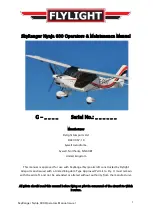
40
41
TIPS FOR CARE
- Over-stressing of individual lines, more than normal load in flight, should be avoided.
An excessive deformation is irreversible and can’t be undone. For the same reason avoid
stepping on the lines, bending or folding them, especially the main lines.
- Always open the glider on clean ground, otherwise dirt could penetrate the fabric,
shorten the lines or damage the canopy. Lines should not be entangled to objects during
the phase of inflation, otherwise they could be deformed or damaged. Never step on the
canopy, especially not on hard ground.
- Take offs and landings under strong wind conditions could force the glider to crash
uncontrolled with high velocity on the ground, the crash could damage fabric and
sewings.
- In case of a Line Over the brake lines could wear of or a main line could be cut by a
brake line or crack by friction.
- Handling the paraglider on a earthy ground under strong wind conditions accelerates
the aging process of your equipment.
- After a water or tree landing the paraglider must be sent for inspection to an authorized
dealer’s workshop.
- It must be avoided that sand, stones or snow enter in the cells, otherwise the weight on
the trailing edge could brake the glider and cause a full-stall. Besides, the sharped edges
could damage the sail’s fabric.
- After the landing be careful, avoid crashing the leading edge on the ground. Otherwise
the material and sewings of the cell openings could be damaged.
- In case the paraglider gets in contact with salty water, he must be washed with
sweet water and dry in the shadow. Never use tools to accelerate the drying process.
Salty water could reduce the line resistance and increase the porosity of the fabric,
even washed out with sweet water.
- After any kind of accident: the equipment must be sent for inspection to an authorized
dealer’s workshop or to the manufacturer.
- Keep up to the required inspection data, to assure that your equipment is always save
for use and within the certification requirements.
INSPECTION
REPAIRS
Your paraglider has strictly to follow the required inspection intervals. The first
inspection check is mandatory completing 24 months or 100 flights, whichever comes
first.
After the first inspection any wing must be checked yearly or at each 100 flights,
whichever comes first. In any of these inspections may occur that a shorter period for
the next inspection will be defined (f. ex. 6 months or 50 flights).
Without performing the mandatory inspections, the paraglider loses its certification and
the warranty becomes null and void.
After any kind of accident or a long period without use: sent the paraglider for inspection
to an authorized dealer’s workshop or to the manufacturer. It’s for your own good.
Minor repairs (see below) you could do by yourself, but all other repairs must only be
made by an authorized dealer’s workshop or the manufacturer.
Repairs must only be made by an authorized dealer’s workshop or to the manufacturer.
In case of minor repairs you are receiving with your glider a basic repair kit. It contains
adhesive labels in case of minor tears and quick link sealing.
Small tears up to 10 cm away from the line suspension points may be fixed by yourself.
Beyond that the maintenance must be made by an authorized dealer’s workshop or the
manufacturer.
- Clean the spot where the adhesive label will be applied with a humid cloth.
- The adhesive label has to be at least 2,5 cm larger than the tear.
- Round the edges, otherwise the adhesive label could loosen after the aplication.
- Apply on both sides of the tear.
In case of a line crack we recommend to contact your dealer, an authorized dealer’s
workshop or the manufacturer. After the repair test the glider on the ground and check
if everything is alright.
Along with your kit you’re get sealing for the quick links. Don’t leave your risers without
them, because they avoid the movement of the screw nut, making it impossible to open.
FABRIC TEARS
LINE CRACK
QUICK LINK SEALING
Содержание LT 1
Страница 1: ...Manual VERSION 1 5 2019 CCC ...











































